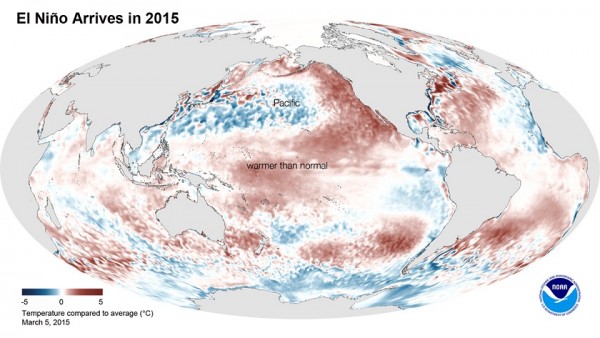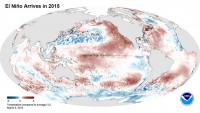‘Worst’ El Niño Could Lead to Base Metals Output Drought in Key Regions
| Eana Maniebo | | May 18, 2015 09:37 AM EDT |
(Photo : NOAA) This image shows the average sea surface temperature for February 2015 as measured by NOAA satellites. The large area of red (warmer than average) can be seen extending through the equatorial Pacific.
According to Australia's Meteorology Bureau, the 2015 El Niño phenomenon can be one of the worst in history despite earlier predictions that it would be weaker than the 2010 occurrence.
Like Us on Facebook
Experts call it 'substantial,' and say that 'it should not be taken lightly.'
"This is a proper El Niño effect-it is not a weak one. There's always a little bit of doubt when it comes to intensity forecasts, but across the models as a whole we'd suggest that this will be quite a substantial El Niño event," David Jones, manager of climate monitoring at the Australian weather agency, told the press according to AFP.
This year's pattern could create drier conditions in Indonesia, Papua New Guinea, and other parts of Southeast Asia such as the Philippines, Cambodia, and Vietnam, as well as extended periods of dampness in South America and several parts of North America.
El Niño is a weather pattern caused by the warming of the Pacific Ocean near the equator and off the coast of South America. The warm water spreading from the west Pacific and Indian Ocean takes the rain with it and causes massive drought to the surrounding areas, introducing increased rainfall across the east-central and eastern Pacific Ocean.
Typically, prolonged droughts in Southeast Asia bring flood to select regions in South America such as Peru and Chile.
According to Mining.com, the mining industry is not immune to El Niño as it is highly dependent on hydroelectric facilities.
In 2010, the El Niño phenomenon led to output drops in Indonesia and Peru, as the former's hydroelectric facilities were affected by water supply shortage while the latter's resource facilities were hit by torrential rains and floods.
Southeast Asia, Australia, and South America are giant producers of base metals.
Small and emerging mining firms are expected to come up with precautionary measures to offset the possible repercussions of El Niño.
This could affect base metal producers from the Philippines, Australia, and Chile.
However, smaller companies outside these regions could help maintain the balance in the supply segment. Amur Minerals Corporation (OTC:AMMCF) is of the few companies that could supply to giant consumers in China and Japan while the global commerce is experiencing shortage from affected areas. The Russian company owns the Kun-Manie Reserve, a nickel-abundant resource facility capable of producing more than 90 million tons of nickel ore.
Nickel and copper mining firms in affected regions are predicted to experience a massive production drought in 2015. Countries from the Southeast Asian region, Australia, South America, India, and Africa are the most vulnerable to the phenomenon.
This could create a spike hike in the entire extracted commodity segment.
Specifically, the weather phenomenon could help weak base metal prices improve on global levels.
Zinc, tin, aluminium, copper, lead, and nickel are among the most important global commodities today. They are essential in various industries such as construction, manufacturing, engineering, aeronautics, automotive, ammunitions, as well as in safety and security.
TagsEl Niño 2015, El Niño in Southeast Asia, El Niño in Australia, El Niño in South America, Worst El Niño, Effects of El Niño in base metals, Amur Minerals, Kun-Manie, El Niño drought
©2015 Chinatopix All rights reserved. Do not reproduce without permission
EDITOR'S PICKS
-

Did the Trump administration just announce plans for a trade war with ‘hostile’ China and Russia?
-

US Senate passes Taiwan travel bill slammed by China
-

As Yan Sihong’s family grieves, here are other Chinese students who went missing abroad. Some have never been found
-

Beijing blasts Western critics who ‘smear China’ with the term sharp power
-

China Envoy Seeks to Defuse Tensions With U.S. as a Trade War Brews
-

Singapore's Deputy PM Provides Bitcoin Vote of Confidence Amid China's Blanket Bans
-

China warns investors over risks in overseas virtual currency trading
-

Chinese government most trustworthy: survey
-

Kashima Antlers On Course For Back-To-Back Titles
MOST POPULAR
LATEST NEWS
Zhou Yongkang: China's Former Security Chief Sentenced to Life in Prison

China's former Chief of the Ministry of Public Security, Zhou Yongkang, has been given a life sentence after he was found guilty of abusing his office, bribery and deliberately ... Full Article
TRENDING STORY

China Pork Prices Expected to Stabilize As The Supplies Recover

Elephone P9000 Smartphone is now on Sale on Amazon India

There's a Big Chance Cliffhangers Won't Still Be Resolved When Grey's Anatomy Season 13 Returns

Supreme Court Ruled on Samsung vs Apple Dispute for Patent Infringement

Microsoft Surface Pro 5 Rumors and Release Date: What is the Latest?











